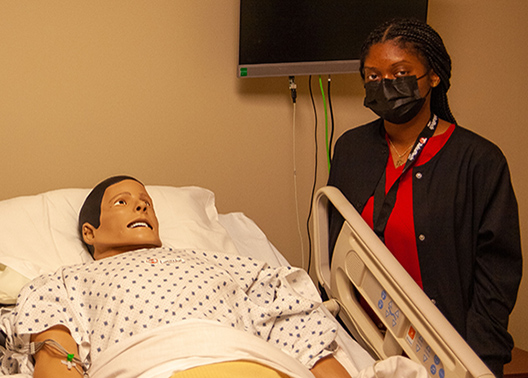Hands-On Training for the Changing World
September 24, 2021

The world has changed dramatically in the last year and a half. While society is slowly moving back to normal, other discoveries have come to the forefront. One of those discoveries is a serious shortage of qualified health care professionals entering the workforce, namely nurses. Tulsa Tech works to help fill that gap with four different nursing pathways.
A crucial part of any health care training is the hands-on clinical experience. The pandemic has made it difficult for students to get the clinical hours they need to graduate and move into the industry. To help meet that need, Tulsa Tech invested in three state-of-the-art simulation labs.
"Students can perfect their skills and provide care to the patient without the threat of positive or negative consequences," Candace Shoopman, Tulsa Tech’s Simulation and Clinical Coordinator, said. "Instructors can then provide critical feedback and help them analyze their thinking to help provide the best care."
This high-tech learning center is housed within the Health Science Center on the Lemley Memorial Campus. These life-like simulators allow students to interact with patients like they would in a clinical setting.
"We can make the simulator respond to any situation, just like a live patient," Shoopman said.
The goal behind utilizing the simulation is simple, allow students to transfer the theory and skills gained in the classroom to a real-world setting. However, simply practicing the skills is not the only benefit.
"It increases the students' confidence," Dana Chandler, Coordinator of Practical Nursing programs, said. "Once they get into the simulation, they see for themselves that they can perform the skills without an instructor or another nurse with them. They are doing it and making the decision, which promotes the critical thinking they need to flourish."
The simulations also provide students with an opportunity for needed feedback. Cameras record each session, and students can go back and watch their performance and give a self-critique before meeting with an instructor.
"The debriefing is a huge help for students," Chandler said with a smile.
"This is likely one of the most significant components other than the actual simulation," Shoopman added. "It allows students to link theory to the actual response."
The need for nurses is expected to grow over the next decade, with a peak around 2030. The most recent report, from 2014, by the United States Bureau of Health Workers shows Oklahoma will be short nearly 2,400 Licensed Practical Nurses (LPN) by 2030. The COVID-19 pandemic has only exacerbated these numbers.
Tulsa Tech is helping meet this growing need with our 15-month, all-day and 18-month, evening Practical Nursing program. These students leave with the ability to test for their LPN certificate.
The simulations also help alleviate the need for clinical hours, as they count toward certification. Students taking part in each simulation receive a nursing report just like they would in a hospital setting and can study that before taking part.
Both Chandler and Shoopman say they have seen benefits for the students.
"I have seen a lot of a-ha moments," Shoopman said.
"Students improve in areas of weakness and can do self-reflection that is not always available in the clinical setting," Chandler said. "It will help when clinical space is not available."
If you are ready to step into a rewarding and in-demand career, look no further than the nursing career training options availalbe at Tulsa Tech.